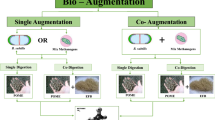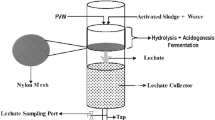Abstract
Vegetable wastes (VW) and food wastes (FW) are generated in large quantities by municipal markets, restaurants and hotels. Waste slurries (250 ml) in 300 ml BOD bottles, containing 3, 5 and 7 % total solids (TS) were hydrolyzed with bacterial mixtures composed of: Bacillus, Acinetobacter, Exiguobacterium, Pseudomonas, Stenotrophomonas and Sphingobacterium species. Each of these bacteria had high activities for the hydrolytic enzymes: amylase, protease and lipase. Hydrolysate of biowaste slurries were subjected to defined mixture of H2 producers and culture enriched for methanogens. The impact of hydrolysis of VW and FW was observed as 2.6- and 2.8-fold enhancement in H2 yield, respectively. Direct biomethanation of hydrolysates of VW and FW resulted in 3.0- and 1.15-fold improvement in CH4 yield, respectively. A positive effect of hydrolysis was also observed with biomethanation of effluent of H2 production stage, to the extent of 1.2- and 3.5-fold with FW and VW, respectively. The effective H2 yields were 17 and 85 l/kg TS fed, whereas effective CH4 yields were 61.7 and 63.3 l/kg TS fed, from VW and FW, respectively. This ecobiotechnological strategy can help to improve the conversion efficiency of biowastes to biofuels.
Similar content being viewed by others
References
Kalia VC (2007) Microbial treatment of domestic and industrialwastes for bioenergy production. Appl Microbiol (e-Book). National Science Digital Library NISCAIR, New Delhi, India. http://nsdl.niscair.res.in/bitstream/123456789/650/1/DomesticWaste.pdf
Kalia VC, Purohit HJ (2008) Microbial diversity and genomics in aid of bioenergy. J Ind Microbiol Biotechnol 35:403–419. doi:10.1007/s10295-007-0300-y
Kumar P, Patel SKS, Lee JK, Kalia VC (2013) Extending the limits of Bacillus for novel biotechnological applications. Biotechnol Adv 31:1543–1561. doi:10.1016/j.biotechadv.2013.08.007
Bouallagui H, Touhami Y, Cheikh RB, Hamdi M (2005) Bioreactor performance in anaerobic digestion of fruit and vegetable wastes. Process Biochem 40:989–995. doi:10.1016/j.procbio.2004.03.007
Kalia VC, Sonakya V, Raizada N (2000) Anaerobic digestion of banana stem waste. Bioresour Technol 73:191–193. doi:10.1016/S0960-8524(99)00172-8
Kalia VC, Jain SR, Kumar A, Joshi AP (1994) Fermentation of biowaste to H2 by Bacillus licheniformis. World J Microbiol Biotechnol 10:224–227. doi:10.1007/BF00360893
Archer DB, Thompson LA (1987) Energy production through the treatment of wastes by micro-organisms. J Appl Bacteriol 63:59s–70s. doi:10.1111/j.1365-2672.1987.tb03612.x
Chu CF, Xu KQ, Li YY, Inamori Y (2012) Hydrogen and methane potential based on the nature of food waste materials in a two-stage thermophilic fermentation process. Int J Hydrogen Energy 37:10611–10618. doi:10.1016/j.ijhydene.2012.04.048
Chuang YS, Lay CH, Sen B, Chen CC, Gopalakrishnan K, Wu JH, Lin CS, Lin CY (2011) Biohydrogen and biomethane from water hyacinth (Eichhornia crassipes) fermentation: effects of substrate concentration and incubation temperature. Int J Hydrogen Energy 36:14195–14203. doi:10.1016/j.ijhydene.2011.04.188
Molino A, Nanna F, Ding Y, Bikson B, Braccio G (2013) Biomethane production by anaerobic digestion of organic waste. Fuel 103:1003–1009. doi:10.1016/j.fuel.2012.07.070
Patterson T, Esteves S, Dinsdale R, Guwy A, Maddy J (2013) Life cycle assessment of biohydrogen and biomethane production and utilisation as a vehicle fuel. Bioresour Technol 131:235–245. doi:10.1016/j.biortech.2012.12.109
Premier GC, Kim JR, Massanet-Nicolau J, Kyazze G, Esteves SRR, Penumathsa BKV, Rodríguez J, Maddya J, Dinsdale RM, Guwya AJ (2013) Integration of biohydrogen, biomethane and bioelectrochemical systems. Renew Energy 49:188–192. doi:10.1016/j.renene.2012.01.035
Xiao L, Deng Z, Fung KY, Ng KM (2013) Biohydrogen generation from anaerobic digestion of food waste. Int J Hydrogen Energy 38:13907–13913. doi:10.1016/j.ijhydene.2013.08.072
Kumar P, Singh M, Mehariya S, Patel SKS, Lee JK, Kalia VC (2014) Ecobiotechnological approach for exploiting the abilities of Bacillus to produce co-polymer of polyhydroxyalkanoate. Ind J Microbiol 54:151–157. doi: 10.1007/s12088-014-0457-9
Sonakya V, Raizada N, Kalia VC (2001) Microbial and enzymatic improvement of anaerobic digestion of waste biomass. Biotechnol Lett 23:1463–1466. doi:10.1023/A:1011664912970
Patel SKS, Kumar P, Kalia VC (2012) Enhancing biological hydrogen production through complementary microbial metabolisms. Int J Hydrogen Energy 37:10590–10603. doi:10.1016/j.ijhydene.2012.04.045
Patel SKS, Kalia VC (2013) Integrative biological hydrogen production: an overview. Indian J Microbiol 53:3–10. doi:10.1007/s12088-012-0287-6
Johnson K, Jiang Y, Kleerebezem R, Muyzer G, van Loosdrecht MCM (2009) Enrichment of a mixed bacterial culture with a high polyhydroxyalkanoate storage capacity. Biomacromolecules 10:670–676. doi:10.1021/bm8013796
Patel SKS, Singh M, Kumar P, Purohit HJ, Kalia VC (2012) Exploitation of defined bacterial cultures for production of hydrogen and polyhydroxybutyrate from pea-shells. Biomass Bioenergy 36:218–225. doi:10.1016/j.biombioe.2011.10.027
Porwal S, Kumar T, Lal S, Rani A, Kumar S, Cheema S, Purohit HJ, Sharma R, Patel SKS, Kalia VC (2008) Hydrogen and polyhydroxybutyrate producing abilities of microbes from diverse habitats by dark fermentative process. Bioresour Technol 99:5444–5451. doi:10.1016/j.biortech.2007.11.011
Patel SKS, Purohit HJ, Kalia VC (2010) Dark fermentative hydrogen production by defined mixed microbial cultures immobilized on ligno-cellulosic waste materials. Int J Hydrogen Energy 35:10674–10681. doi:10.1016/j.ijhydene.2010.03.025
Kalia VC, Kumar A, Jain SR, Joshi AP (1992) Biomethanation of plant materials. Bioresour Technol 41:209–212. doi:10.1016/0960-8524(92)90003-G
Kalia VC, Joshi AP (1995) Conversion of waste biomass (pea-shells) into hydrogen and methane through anaerobic digestion. Bioresour Technol 53:165–168. doi:10.1016/0960-8524(95)00077-R
Acknowledgments
The authors wish to thank the Director of CSIR-Institute of Genomics and Integrative Biology (IGIB), Delhi, CSIR-WUM (ESC0108) and Department of Biotechnology (DBT-BT/PR-11517/BCE/08/709/2008) Government of India for providing necessary funds and facilities. PK is thankful to CSIR for granting Senior Research Fellowship.
Author information
Authors and Affiliations
Corresponding author
Additional information
Prasun Kumar and Dinesh Chander Pant have Contributed equally to this study.
Electronic supplementary material
Below is the link to the electronic supplementary material.
Rights and permissions
About this article
Cite this article
Kumar, P., Pant, D.C., Mehariya, S. et al. Ecobiotechnological Strategy to Enhance Efficiency of Bioconversion of Wastes into Hydrogen and Methane. Indian J Microbiol 54, 262–267 (2014). https://doi.org/10.1007/s12088-014-0467-7
Received:
Accepted:
Published:
Issue Date:
DOI: https://doi.org/10.1007/s12088-014-0467-7




